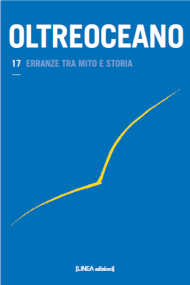L’immaginario labirintico nel romanzo quebecchese: dal mito classico al labirinto contemporaneo
DOI:
https://doi.org/10.53154/Oltreoceano2Keywords:
labirinto, Québec, romanzoAbstract
La lettura dell’erranza nel romanzo quebecchese evidenzia la presenza di un labirinto universale nel quale si iscrivono altri labirinti. La fondazione del Québec, il suo passato hanno influenzato la scrittura creando immaginari labirintici evidenti in molti romanzi quebecchesi contemporanei.
The Labyrinthine Imagination in the Québec Novel: From the Classic Myth to the Contemporary Labyrinth
The representation of travel in the works of Québec writers reveals the presence of a universal labyrinth in which other labyrinths are inscribed. The labyrinthine imagination which surfaces in many contemporary novels is linked both to the foundation of Québec and its past marked by colonization, the relationship with France and the proximity with the United States.
Downloads
References
Alighieri, D. (2010): Comedìa. Rimini: Fara.
Bauman, Z. (2011): Modernità liquida. Roma / Bari: Laterza.
Biron, M., Dumont, F. & Nardout-Lafarge, É. (2010): La nouvelle histoire de la littérature québécoise. Montréal: Boréal.
Bishop, N. B. (2010): Pluralismes et parcours des pays littéraires d’Anne Hébert. Les Cahiers d’Anne Hébert, 9, pp. 23-42.
Boivin, A. (1995): Volkswagen Blues ou la recherche d’identité. Québec français, 97, pp. 90-93.
Charles, J.-C. (2001): L’enracinerrance. Boutures, 1, 4, pp. 37-41.
Dictionnaires de français Larousse en ligne (2020). Recuperato da http://larousse.fr/dictionnaires/francais
Doyen, Ch. (2004): L’image du labyrinthe dans l’Enfer de Dante. Tiré de http://bcs.flts.ucl.ac.be/FE/07/Labyrinthe.html#1
Durrenmatt, F. (2011): Il mio labirinto. In F. Durrenmatt, Il minotauro (pp. 7-37). Milano: Marcos y Marcos.
Eco, U. (2012): Il nome della rosa. Milano: Bompiani.
Eliade, M. (1963): Aspects du mythe. Paris: Gallimard.
Émond, M. (2000): Le récit québécois comme fil d’Ariane. Québec: Nota bene.
Étiembre, Y. (2013): Parcourir le labyrinthe (fin). Du pèlerin au nomade. Le labyrinthe. Mythe et Symbole. Recuperato da http://agoras.typepad.fr/regard_eloigne/2013/08/parcourir-le-labyrinthefindu-pelerin-au-nomadele-labyrinthe-mythe-et-symbole.html
Féral, J. (2006): Clôture du moi, clôture du texte dans l’œuvre d’Anne Hébert. In J. M. Paterson & L. Saint-Martin (Eds.), Anne Hébert en revue (pp. 11-29). Sainte-Foy: Voix et Images / Les Presses de l’Université du Québec.
Genette, G. (1976): Figures, I. Paris: Seuil.
Gérin-Lajoie, A. (1842): Complainte du Canadien errant. Recuperato da http://www.cours-quebec.info/index.php?option=com_content&view=article&id=104&Itemid=91
Gervais, B. (2014): Géopoétique des lignes brisées: musements, chants de pistes et labyrinthes hypermédiatiques. Formes poétiques contemporaines, 11, pp. 31-48.
Guillemette, L. (2006): Pour une nouvelle lecture des Fous de Bassan d’Anne Hébert: l’Amérique et ses parcours discursifs. In J. M. Paterson & L. Saint-Martin (Eds.), Anne Hébert en revue (pp. 143-161). Sainte-Foy: Voix et Images / Les Presses de l’Université du Québec.
Hébert, A. (1982): Les fous de Bassan. Paris: Seuil.
Huston, N. (2013): Reflets dans l’œil d’homme. Arles: Actes Sud.
Lemire, M. (2003): Le mythe de l’Amérique dans l’imaginaire canadien. Québec: Nota bene.
Lovito, G. (2013): Le mythe du labyrinthe revisité par Eco théoricien et romancier à des fins cognitives et métaphoriques. Cahiers d’études romanes, 27, pp. 345-357.
Morency, J. (1995): L’errance dans le roman québécois. Québec français, 97, pp. 81-84.
Paterson, J. M. (2007): Les passages obligés de l’écriture migrante. Recuperato da http://muse.jhu.edu/journals/university_of_toronto_quarterly/summary/v076/76.1paterson02.html
Peyronie, A. (1988): Labyrinthe. In P. Brunel (Ed.), Dictionnaire des mythes littéraires (pp. 915-950). Monaco: Rocher.
Poulin, J. (1984): Volkswagen Blues. Montréal: Québec Amérique.
Santarcangeli, P. (1984): Il libro dei labirinti. Storia di un mito e di un simbolo. Milano: Frassinelli.
Sauvaire, M. (2011): De l’exil à l’errance, la diversité des sujets migrants. Amerika, 5. Recuperato da http://amerika.revues.org/2511
Sirois, A. (1992): Mythes et symboles dans la littérature québécoise. Montréal: Triptyque.
Vargas Llosa, M. (1993): Lituma en los Andes. Madrid: Planeta.
Downloads
Published
How to Cite
Issue
Section
License

This work is licensed under a Creative Commons Attribution-NonCommercial-ShareAlike 4.0 International License.
The authors undertake to comply with the following conditions, which are considered accepted at the time of submission of their contributions.
The sending of a text implies that it is unpublished and not submitted to be published elsewhere.
1. If accepted, the author shall confer on the publisher the right to publish and distribute it both in paper form and in the online electronic edition. The published articles will be downloadable and made available in open access.
2. Provided that it correctly indicates that the first publication took place in the journal Oltreoceano. Rivista sulle migrazioni the author has the right to: a) reproduce the article in separate extracts or collected in a volume; b) publish the article on their personal website or teaching site provided that these sites are of a non-commercial nature; c) deposit the article in online archives of a non-commercial nature, linked to the institution they belong to or as part of projects for the non-commercial dissemination and open access of scientific works.
The use of contributions by third parties, for commercial or otherwise unauthorized purposes, is not allowed. The publisher declines all responsibility for the unauthorized use of the material published in the journal.












